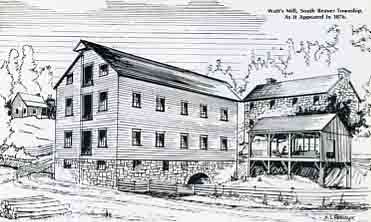
Watt's Mill, South Beaver Township.
Return to Milestones Vol. 3, No. 4
From: Historical Collections of Little Beaver By IRA F. MANSFIELD, 1911. Submitted to Milestones by Don Inman.
The grinding of grain preparatory to its use as food for man and beast was a matter of primary concern with the early settlers. While there has been a gradual evolution from the Indians stone and wooden mortars with pestals, no "two women were ever seen grinding at the mill," on the Little Beaver. Many of our early mills were of crude construction and their effect on the grain was little more than to crush it without any provision for bolting. Among the first mills was one erected by George Foulks at Cannelton in 1798. Some Indian visitors expressed surprise that white man would go to so much trouble, but when George Foulks got his mill under way and there was meal for everyone and surplus for the Indians' hound dogs they were pleased. The Foulks mill has been rebuilt twice and is now carried on by Reuben Watt and sons and still enjoys an excellent local trade, especially for its buckwheat flour. Another early flour mill was built by the Caughey Brothers in Darlington in 1806. The same year at Achor, 0., Baltzer Young erected a three story mill. Both of these mills had six foot log dams with extended races giving double water power.

A careful estimate shows seventy-two flour and grist mills, with over two hundred saw mills located on-the Little Beaver. Today there are only two operated, Watts at Cannelton and Crawford's at Frederick and both mills nearing their end. A careful study of the early mills refute statements of the histories of Beaver and Columbiana counties that there was a lack of skilled mechanics or wherewithal to pay such workmen as were found. In every settlement, even with the few tools they had, excellent dams, nicely squared and dressed stone foundations, smooth hewed frames with all necessary mill machinery to meet conditions required show well today. The stones used for grinding were occasionally imported from France or made from our native granite boulders. Many of these early mill stones show the Lake Superior formation with fossil shells and copper crystals. Within the last few years grinding by the use of Burr stones has been supplanted by the roller process, yielding a whiter flour at the sacrifice of the glutin. This demand for white or starch flours made by mixing Dakota or "Reciprocity Wheat" has monopolized the entire trade, leaving our local mills the unprofitable chopping business that results in closing out every water power mill. Several paper mills, woolen mills, with flax and oil mills linger in the memories of the older people, all of them famous for their products.
At almost every early mill was a distillery. Good old Matthew Elder who commanded a large trade at his store and woolen mill near Cannelton, required every customer man or woman to "come in and have a toothfull of rum, and never knew even ministers to refuse."
With the decay of our water mills it is refreshing to hear amid the clamor for a "New Nationalism" a voice now and again raised in behalf of a "New Localism." Most significant of the past few years is the centralization of manufacturing which, while it has given us better flours and cheaper fabrics, has cost the Little Beaver communities dear. Our flour is largely made in Minneapolis, woolens in Philadelphia, shoes in Lynn.
Village stores, shoemakers, blacksmiths and tailors along with water mills have all been driven to the wall by centralization and with them the decline of our country schools, brought around by state aid to the Normal Schools, all glorifying the state at the expense of the individual unit. Conservation of our water power and a new localism must keep pace with new nationalism so that farm communities comes into their own. The loss of all our old industries is a problem well worth the solving by our Granges and farmers' clubs.
Below we give the names and dates of the most "prominent" mills, that have been operated on the several branches of the Little Beaver:
NORTH FORK
Foulk's and Watt's mill 1798, Cannelton,
Pa.
Hughes' mill 1824, Cannelton, Pa.
Morris' mill, 1840, Cannelton, Pa.
Bartram's mill, 1815, Cannelton, Pa.
Elder's mill, 1828, Cannelton, Pa.
Caughey's mill, 1806, Darlington, Pa.
Lowrey's mill, 1812, Darlington, Pa.
Young's mill, 1806, Achor, 0.
Crawford's mill, 1838, Frederick, 0.
Witherspoon's mill, 1820, New Galilee, Pa.
Patterson's mill, 1860, New Galilee, Pa.
Wells' mill, 1818, New Galilee, Pa.
Walters' mill, 1829, Old Enon, Pa.
Ramage's mill, 1840, Old Enon, Pa.
MIDDLE FORK
Stone's mill, 1834, Spruce Vale, 0.
Vondergreen's mill, 1840, Vondergreen's, 0.
Grey's mill, 1842, Grey's, 0.
Gaston's mill, 1840, Gaston's, 0.
Crawford's mill, 1809, Williamsport, 0.
Kemble's mill, 1830, Kemble, 0.
McClure's mill, 1835, Elk Run, 0.
Dilworth's mill, 1838, Elk Run, 0.
Harbaugh's mill, 1820 Elkton, 0.
Hughes' mill, 1824, Oid Furnace, 0.
Blackledge mill, 1839, Teegarden, 0.
Jacob Roller mill, 1820, Leetonia, 0.
People's mill, 1840, Franklin, 0.
WEST FORK
Scott's mill, 1821.
McCaskey's mill, 1822.
Baugh's mill, 1830.
Dobson's mill, 1825.
Adam Poe's mill, 1803.
Cannon's mill, 1820.
Bough's mill, 1828.
McVaig's mill, 1835.
Frost's mill, 1824.
Richey's mill, 1838.
Glenn's mill, 1820.